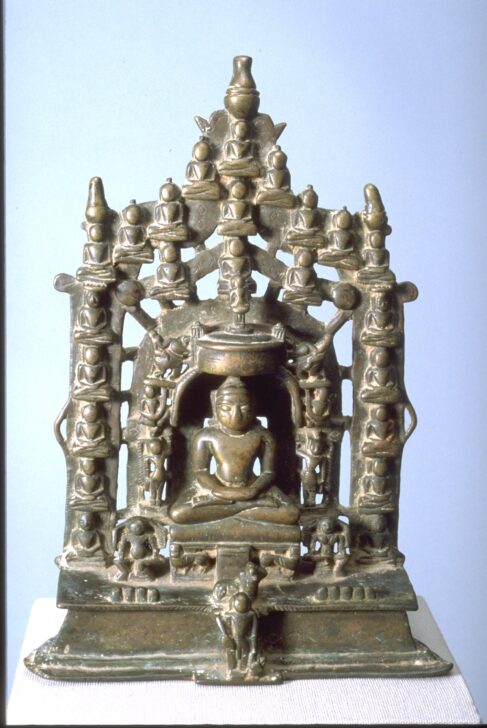Caturvimsati Pata (Shrine of the 24 Jinas)
Indian

Description
March 28, 2009
The essence of Jainism is a concern for the welfare of every being, and so it teaches that the way to happiness is to live lives of harmlessness and renunciation. Jains are guided in their beliefs by a group of twenty-four Jinas, also known as tirthankara, who can cross the gulf between the material world and liberation. Like Buddhism, which developed around the same time (the sixth century BCE or earlier), Jainism quickly adopted the use of images and shrines to focus the worshipers’ attention.
This shrine is devoted to the Jina Rishabha, who is seated in meditation at its center and surrounded by the twenty-three other Jinas in the same pose. An inner tier of seated and standing figures represents a variety of attendants, distinguished from the Jinas by slightly different postures. The figures are thoroughly integrated with the shrine’s structure and are surmounted by auspicious pot forms. According to Jain narratives, Rishabha, the primordial tirthankara, taught mankind the arts that separate it from beasts, including the kindling of fire. He also established the basic structures of society by dividing people into classes according to their occupations.
(Label for UMMA South and Southeast Asia Gallery Opening Rotation, March 2009)
(South and Southeast Asia Gallery Rotation, Fall 2010)
Gallery Rotation Fall 2010
Rishabha shrine
India, Gujarat
1464
Bronze or brass
Gift of Dr. and Mrs. Leo S. Figiel and Dr. and Mrs. Steven J. Figiel, 1975/2.120
The essence of Jainism is a concern for the welfare of every being, and so it teaches that the way to happiness is to live a life of harmlessness and renunciation. Jains are guided in their beliefs by a group of twenty-four Jinas, also known as tirthankaras, or perfected beings, who can cross the gulf between the material world and liberation. Like Buddhism, which developed around the same time (the sixth century BCE or earlier), Jainism quickly adopted the use of images and shrines as tools or devices to focus the worshipers’ attention.
This shrine is devoted to the Jina Rishabha, who is seated in meditation at its center and surrounded by the twenty-three other Jinas in the same pose. An inner tier of seated and standing figures represents a variety of attendants, distinguished from the Jinas by slightly different postures. The figures are thoroughly integrated with the shrine’s structure and are surmounted by auspicious pot forms. According to Jain narratives, Rishabha, the primordial tirthankara, taught mankind the arts that separate them from beasts, including the kindling of fire. He also established the basic structures of society by dividing people into classes according to their occupations.
Subject Matter:
Identified as the jina Rishabha by the bull before his throne, Rishabha or Adinatha is the first of the Jaina line of teachers. Loosely translated as Spiritual Victors and called Peaceful Liberators in an important exhibition catalogue, there is a line of twenty-four jinas in Jainism. Their other important title is tirthamkara, or “ford crosser” designating them as figures who can teach others in the means for liberation. Jaina cosmology consists of a constant swing from perfection to dissolution and twenty-four jinas map out this progression. Rishabha, as the first existed at a time when the perfect state began to dissolve, had to teach people how to cope. For instance, when Wish Fulfilling Trees stopped producing, he had to teach people agriculture. He had to teach them pottery, statecraft and many other things. Rishabha, the primordial tirthankara, taught mankind the arts that separate them from beasts, including the kindling of fire. He also established the basic structures of society by dividing people into classes according to their occupations. On this altarpiece there are 23 teachers surround him. The rituals used for Jaina images are often the same as used in Hinduism and there is some confusion over this in the literature. Hindus consider them gods, but Jainas do not, but they are objects of reverence.
Physical Description:
This shrine depicts a large seated Jina surrounded by 23 other jina figures and a variety of attendants. The Jina figures that adorn the sides and are arranged in tiers above the main figure. The side columns and the whole is surmounted by auspicious pot forms. The main figure sits in the lotus position on a lion throne flanked by a male and female demigod. Along the sides he is flanked by standing cauri bearers, garland bearers above them and riders on elephants above that with an umbrella with a standing figure on it above his head. At the base in the center is a standing figure holding a sick or club with a bull cognizance behind him on the base of the throne. The nine globs on the base, four to his right and five to his left represent the nine planets and his hands folded in a gesture of meditation
Usage Rights:
If you are interested in using an image for a publication, please visit https://umma.umich.edu/request-image/ for more information and to fill out the online Image Rights and Reproductions Request Form.